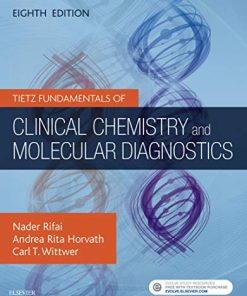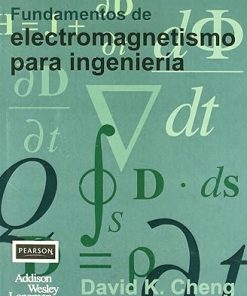(Ebook PDF) Tietz fundamentos de química clínica e diagnóstico molecular 7th Edition by Carl Burtis 8535281665 978-8535281668 full chapters
$50.00 Original price was: $50.00.$25.00Current price is: $25.00.
Tietz fundamentos de química clínica e diagnóstico molecular 7th Edition by Carl A. Burtis – Ebook PDF Instant Download/DeliveryISBN: 8535281665, 978-8535281668
Full dowload Tietz fundamentos de química clínica e diagnóstico molecular 7th Edition after payment.

Product details:
ISBN-10 : 8535281665
ISBN-13 : 978-8535281668
Author: Carl A. Burtis
Tietz fundamentos de química clínica e diagnóstico molecular 7th Table of contents:
Part I Principles Of Laboratory Medicine
Chapter 1 Clinical Chemistry, Molecular Diagnostics, and Laboratory Medicine
Objectives
Key Words and Definitions
Laboratory Medicine
BOX 1-1 Uses of Testing in the Clinical Laboratory
BOX 1-2 Disciplines of the Modern-Day Clinical Laboratory
Clinical Chemistry and Laboratory Medicine
Molecular Diagnostics
Ethical Issues in Laboratory Medicine
BOX 1-3 Ethical Issues in Clinical Chemistry and Molecular Diagnostics
Confidentiality of Genetic Information
Confidentiality of Patient Medical Information
Allocation of Healthcare Resources
Business Ethics
Codes of Conduct
Publishing Issues
Conflict of Interest
Review Questions
References
Chapter 2 Selection and Analytical Evaluation of Methods—With Statistical Techniques∗
Objectives
Key Words and Definitions
Method Selection
Medical Usefulness Criteria
Analytical Performance Criteria
Figure 2-1 Flow diagram that illustrates the process of introducing a new method into routine use. The diagram highlights the key steps of method selection, method evaluation, and quality control.
BOX 2-1 Abbreviations
Other (Practical) Criteria
Basic Statistics
Frequency Distribution
Population and Sample
Figure 2-2 Frequency distribution of 100 γ-GGT values.
Probability and Probability Distributions
Figure 2-3 Population frequency distribution of γ-GGT values.
Parameters: Descriptive Measures of a Population
Statistics: Descriptive Measures of the Sample
Random Sampling
The Gaussian Probability Distribution
Figure 2-4 The Gaussian probability distribution.
Student t Probability Distribution
Figure 2-5 The t probability distribution for ν = 1, 10, and ∞.
Basic Concepts in Relation to Analytical Methods
Calibration
Figure 2-6 Relation between concentration (x) and signal response (y) for a linear calibration curve. The dispersion in signal response (σy) is projected onto the x-axis, giving rise to assay imprecision (σx).
Trueness and Accuracy
TABLE 2-1 An Overview of Qualitative Terms and Quantitative Measures Related to Method Performance
Precision
TABLE 2-2 Factors Corresponding to 95% CI Limits for an SD (the number of degrees of freedom is N − 1)
Precision Profile
Linearity
Figure 2-7 Relations between analyte concentration and SD/CV. A, The SD is constant so that the CV varies inversely with the analyte concentration. B, The CV is constant because of a proportional relationship between concentration and SD. C, Illustration of a mixed situation with constant SD in the low range and a proportional relationship in the rest of the analytical measurement range.
Analytical Measurement Range and Limits of Quantification
Analytical Sensitivity
Analytical Specificity and Interference
Analytical Goals
TABLE 2-3 Hierarchy of Procedures for Setting Analytical Quality Specifications for Laboratory Methods
Qualitative Methods
Figure 2-8 Cumulative frequency distribution of positive results. The x-axis indicates concentrations standardized to zero at the cutoff point (50% positive results) with unit SD.
Method Comparison
Basic Error Model
Measured Value, Target Value, Modified Target Value, and True Value
Calibration Bias and Random Bias
Figure 2-9 Outline of basic error model for measurements by a field method. Upper part: The distribution of repeated measurements of the same sample, representing a Gaussian distribution around the target value (vertical line) of the sample with a dispersion corresponding to the analytical standard deviation, σA. Middle part: Schematic outline of the dispersion of target value deviations from the respective true values for a population of patient samples. A distribution of an arbitrary form is displayed. The vertical line indicates the mean of the distribution. Lower part: The distance from zero to the mean of the target value deviations from the true values represents the calibration bias (Mean bias = Cal-Bias) of the method.
Mistakes or Clerical Errors
Method Comparison Data Model
Comparison of a Routine Method With a Reference Method
Comparison of Two Routine Methods
Planning a Method Comparison Study
Difference (Bland-Altman) Plot
Figure 2-10 Bland-Altman plot of differences for the drug comparison example. The differences are plotted against the average concentration. The mean difference (42 nmol/L) with ±2 SD of differences is shown (dashed lines).
Figure 2-11 Bland-Altman plot of relative differences for the drug comparison example. The differences are plotted against the average concentration. The mean relative difference (0.042) with ±2 SD of relative differences is shown (dashed lines).
Difference (Bland-Altman) Plot With Specified Limits
TABLE 2-4 Lower Bounds (One-Sided 95% CI) of Observed Proportions (%) of Results Located Within Specified Limits for Paired Differences That Are in Accordance With the Hypothesis of at Least 95% of Differences Being Within the Limits
Regression Analysis
Figure 2-12 Illustration of the systematic difference c between two methods at a given level X1c according to the regression line. The difference is a result of a constant systematic difference (intercept deviation from zero) and a proportional systematic difference (slope deviation from unity). The dotted line represents the diagonal X2 = X1.
Error Models in Regression Analysis
Figure 2-13 Outline of the relation between x1 and x2 values measured by two methods subject to random error with constant SDs over the analytical measurement range. A linear relationship between the target values (X1′Targeti, X2′Targeti) is presumed. The x1i and x2i values are Gaussian distributed around X1′Targeti and X2′Targeti, respectively, as schematically shown. σ21 (σyx) is demarcated.
Figure 2-14 Outline of the relation between x1 and x2 values measured by two methods subject to proportional random errors. A linear relationship between the target values is assumed. The x1i and x2i values are Gaussian distributed around X1′Targeti and X2′Targeti, respectively, with increasing scatter at higher concentrations as schematically shown.
Deming Regression Analysis and Ordinary Least-Squares Regression Analysis (Constant SDs)
Figure 2-15 The model assumed in ordinary OLR. The x2 values are Gaussian distributed around the line with constant SD over the analytical measurement range. The x1 values are assumed to be without random error. σ21 (σyx) is shown.
Figure 2-16 In OLR, the sum of squared deviations from the line is minimized in the vertical direction. In Deming regression analysis, the sum of squared deviations is minimized at an angle to the line depending on the random error ratio. Here the symmetric case is displayed with orthogonal deviations.
Figure 2-17 Relations between the true (expected) slope value and the average estimated slope by OLR. The bias of the OLR slope estimate increases negatively for increasing ratios of the SD random error in x1 to the SD of the X1 target value distribution.
Computation Procedures for OLR and Deming Regression
Figure 2-18 Simulated comparison of two sodium methods. The solid line indicates the average estimated OLR line, and the dotted line is the identity line. Even though there is no systematic difference between the two methods, the average OLR line deviates from the identity line corresponding to a downward slope bias of about 10%.
Evaluation of the Random Error Around an Estimated Regression Line
Interpreting SDy•x (SD21) With Random Errors in Both x1 and x2
Assessment of Outliers
The Correlation Coefficient
Figure 2-19 A, A scatter plot with the Deming regression line (solid line) with an outlier (filled point). The dotted straight line is the diagonal, and the curved dashed lines demarcate the 95% confidence region. B, Standardized residuals plot with indication of the outlier.
Regression Analysis in Case of Proportional Random Errors
Testing for Linearity
Figure 2-20 Scatter plots illustrating the effect of the range on the value of the correlation coefficient ρ. A, The target values are uniformly distributed over the range 1 to 3 with random errors of both x1 and x2 corresponding to an SD of 5% of the target value at 3 (constant error SDs). B, The range is extended to 1 to 6 with the same random error levels. The correlation coefficient equals 0.93 in A and 0.99 in B. In C, the effect of a single aberrant point is shown. Forty-nine of the target values are distributed over the range 1 to 3 with a single point at 6. The correlation coefficient is 0.97.
Figure 2-21 Distances from data points to the line in weighted Deming regression, assuming proportional random errors in x1 and x2. The symmetrical case is illustrated with equal random errors and a slope of unity, yielding orthogonal projections onto the line.
Nonparametric Regression Analysis (Passing-Bablok)
Figure 2-22 Top, Scatter plot showing an example of nonlinearity in the form of downward deviating x2 values at the upper part of the range. Bottom, Plot of residuals showing the effect of nonlinearity. At the upper end of the analytical measurement range, a sequence (run) of negative residuals is present from x = 150 to 200.
Interpretation of Systematic Differences Between Methods Obtained on the Basis of Regression Analysis
Example of Application of Regression Analysis (Weighted Deming Analysis)
Figure 2-23 An example of weighted Deming regression analysis for the comparison of drug assays. A, The solid line is the estimated weighted Deming regression line, the dashed curves indicate the 95% confidence region, and the dotted line is the line of identity. B is a plot of residuals standardized to unit SD. The homogeneous scatter supports the assumed proportional error model and the assumption of linearity.
TABLE 2-5 Results of Weighted Deming Regression Analysis for the Comparison of Drug Assays Example, N = 65 (x1, x2) Measurements
Discussion of Application of Regression Analysis
Monitoring Serial Results
Traceability and Measurement Uncertainty
Traceability
Figure 2-24 The calibration hierarchy from a reference measurement procedure to a routine method. The uncertainty increases from top to bottom.
The Uncertainty Concept
The Standard Uncertainty (ust)
Example of Direct Assessment of Uncertainty on the Basis of Measurements of a Commutable Certified Reference Material
Indirect Evaluation of Uncertainty by Quantification of Individual Error Source Components
TABLE 2-6 Relations Between Standard Deviation and Range for Various Types of Distributions
Software Packages
Review Questions
References
Chapter 3 Clinical Evaluation of Methods
Objectives
Key Words and Definitions
Sensitivity and Specificity
TABLE 3-1 Classifications of a Test Result Applied to Unaffected and Diseased Populations
Figure 3-1 Prostate-specific antigen (PSA) concentrations for patients with benign prostatic hyperplasia (BPH) and known prostatic carcinoma (CA) are shown with two decision-level cutoffs.
Figure 3-2 Simulated distributions of unaffected and diseased populations. Note that the ratio of diseased patients to healthy patients, A to B, is less than 1 and is very different at the point of decision (the likelihood ratio) from the ratio of TP to FP, which is much greater than 1. FN, False negative; FP, false positive; TN, true negative; TP, true positive.
Receiver Operating Characteristic Plots7
Figure 3-3 Receiver operating characteristic curve of prostate-specific antigen (PSA). Each point on the curve represents a different decision level. The sensitivity and 1 − specificity can be read for tests A and B, with 4 and 10 μg/L as decision thresholds, respectively.
Probabilistic Reasoning
Prevalence
Predictive Values
Odds Ratio
Likelihood Ratio
Figure 3-4 Receiver operating characteristic curve illustrating the slopes that define the likelihood ratio (LR) for a continuous test at a specific test result (the gray point) and the positive likelihood ratio (LR+) and the negative likelihood ratio (LR−) of a dichotomous test.6
Bayes’ Theorem
Limitations of Bayes’ Theorem
Combination Testing
TABLE 3-2 Combination Test Performance Maximizing Specificity∗
Example 1
TABLE 3-3 Combination Test Performance Maximizing Sensitivity∗
Example 2
Methods of Assessing Diagnostic Accuracy
Review Questions
References
Chapter 4 Evidence-Based Laboratory Medicine
Objectives
Key Words and Definitions
Evidence-Based Medicine—What Is It?
Definition and Goals of Evidence-Based Medicine
The Practice of Evidence-Based Medicine
Evidence-Based Medicine and Laboratory Medicine
What Is Evidence-Based Laboratory Medicine?
Types of Diagnostic Questions Addressed in Laboratory Medicine
Figure 4-1 Schematic representation of four common decision-making steps in which the result of an investigation is involved.
Using the Test Result
Test Results Alone Do Not Produce Clinical Outcomes
Information Needs in Evidence-Based Laboratory Medicine
TABLE 4-1 Examples of Clinical Questions for Which a Laboratory Assessment May Be of Value, and the Associated Action and Potential Outcome (Benefit)
Characterization of Diagnostic Accuracy of Tests
Study Design
Reporting of Studies of Diagnostic Accuracy and the Role of the STARD Initiative
Outcomes Studies
What Are Outcomes Studies?
Figure 4-2 STARD checklist.
Figure 4-3 STARD flow diagram.
Why Outcomes Studies?
Design of Studies of Medical Outcomes
Systematic Reviews of Diagnostic Tests
Why Systematic Reviews?
Conducting a Systematic Review
The Clinical Question and Criteria for Selection of Studies
BOX 4-1 Selected Key Steps in a Systematic Review of a Diagnostic Test
Search Strategy
Data Extraction and Critical Appraisal of Studies
Summarizing the Data
Meta-Analysis
Economic Evaluations of Diagnostic Testing
A Hierarchy of Evidence
Methodologies for Economic Evaluations
TABLE 4-2 Approaches to Economic Evaluation
Perspectives of Economic Evaluations
Figure 4-4 A summary of the incremental cost-effectiveness plan.
Quality of Economic Evaluations
Use of Economic Evaluations in Decision Making
Clinical Practice Guidelines
What Is a Clinical Practice Guideline?
Use of Transparency in the Development of Guidelines
Steps in the Development of Guidelines
Selection and Refinement of a Topic
Figure 4-5 Steps in the development of a clinical practice guideline.
Determination of Target Group and Establishment of a Multidisciplinary Guideline Development Team
Identifying and Assessing the Evidence
Translating Evidence Into a Guideline and Grading the Strength of Recommendations
TABLE 4-3 A Scheme for Rating the Quality of Evidence in Grading the Strength of Recommendations in Clinical Guidelines
Obtaining External Review and Updating the Guidelines
TABLE 4-4 Hierarchy of Criteria for Quality Specifications
Clinical Audit
Audit to Help Solve Problems
Figure 4-6 The audit cycle.
Audit to Monitor Workload and Demand
Audit to Monitor the Introduction of a New Test
Audit to Monitor Variation Between Providers and Adherence to Best Practice
Applying the Principles of Evidence-Based Laboratory Medicine in Routine Practice
Review Questions
References
Chapter 5 Establishment and Use of Reference Values∗
Objectives
Key Words and Definitions
Establishment of Reference Values
Background
Selection of Reference Individuals
BOX 5-1 Examples of Exclusion Criteria for Health-Associated Reference Values∗
Diseases
Risk Factors
Intake of Pharmacologically Active Agents
Specific Physiological States
BOX 5-2 Examples of Partitioning Criteria for Possible Subgrouping of the Reference Group
Age (not necessarily categorized by equal intervals)
Gender
Genetic Factors
Physiological Factors
Other Factors
Specimen Collection
Analytical Procedures and Quality Control
Statistical Treatment of Reference Values
Partitioning of Reference Values
Inspection of Distribution
Figure 5-1 Observed distribution of 124 γ-glutamyltransferase (GGT) values in serum (IU/L). This distribution is clearly not Gaussian; it appears skewed to the right. The upper arrow indicates the range of observed values (highest − lowest, or 74 − 6 = 68); the lower arrow indicates the difference between the highest value and the next highest value (74 − 50 = 24). Because the quotient (24/68 = 0.35) exceeds 0.33, Dixon’s range test indicates that the highest value is an outlier and therefore is omitted from all further analyses.
Identification and Handling of Outliers
Determination of Reference Limits
Nonparametric Method
Parametric Method
TABLE 5-1 Nonparametric Confidence Intervals of Reference Limits∗
TABLE 5-2, A γ-Glutamyltransferase (GGT) Values Used in the Nonparametric Determination of Reference Intervals
TABLE 5-2, B Nonparametric Determination of Reference Interval∗
Figure 5-2 Distribution of 123 remaining γ-glutamyltransferase (GGT) values from reference subjects. A, A histogram of the original, untransformed data. B, The cumulative frequency of the data from A, plotted on Gaussian probability paper. C, A histogram of the logarithmic transformed data. D, The cumulative frequency of the data from C, plotted on Gaussian probability paper.
TABLE 5-3 Summary of GGT Reference Interval Determination by Three Methods
Other Methods for Calculating Reference Limits
Use of Reference Values
Presentation of an Observed Value in Relation to Reference Values
Subject-Based Reference Values
Figure 5-3 The relationship between population-based and subject-based reference distributions and reference intervals. The example is hypothetical, and the two distributions are, for simplicity, Gaussian. Hypothetical means and standard deviations are μ and σ (for the population) and μi and σi (individual i); x, analysis result.
Figure 5-4 Serial immunoglobulin M (IgM) values over several days from reference individuals. Note that intraindividual variability is very small compared with interindividual variability.
Transferability (Transference) of Reference Values
Analytical Issues
Multicenter Trials
Verification of Transfer
Figure 5-5 A, A basic 2 × 2 table (bold lines) facilitates understanding of the concepts of sensitivity, specificity, and predictive value. In the left-hand column, all patients with positive test results are tabulated; in the right-hand column, all patients with negative test results are tabulated. In the top row, patients with the disease under study are divided by their test results; likewise, the bottom row (show shading symbol) divides people without the disease by their test results. The top left-hand corner, then, represents patients with disease who have positive results, TRUE POSITIVES. The other three boxes are as labeled. As shown, the clinical sensitivity is calculated using the top row; the clinical specificity is calculated using the bottom row. The predictive value of a positive test is calculated using the data in the left-hand column; the predictive value of a negative test, using the right-hand column. B, The calculations described in A are done on test X, whose sensitivity and specificity are 95% and 90%, respectively. For this example, the prevalence of the population tested is 50%, reflected in the fact that 100 people with disease and 100 people without disease are tested. Of note, this is frequently the prevalence used when tests are first described in the literature. As shown, the predictive value of a positive test is 90%. C, The same calculations are done on the same test X, but the prevalence used is a more realistic, but still quite high, 5%, reflected in the fact that 500 people have the disease and 9500 do not. Although the sensitivity and specificity remain unchanged (95% and 90%, respectively), the predictive value of a positive test is now just 5%, that is, the likelihood that a patient with a positive test result in this population actually has the disease is 5%, or, in other words, 67% of the positive results are FALSE POSITIVES.
Clinical Sensitivity and Specificity and Predictive Value
Figure 5-6 Simulated distributions of healthy and diseased populations. Note that at the shown decision threshold, the probability of a subject with disease (a) is much less than the probability of a healthy subject (b). TN, true negatives; TP, true positives; FN, false negatives; FP, false positives.
Review Questions
References
Chapter 6 Specimen Collection, Processing, and Other Preanalytical Variables∗
Objectives
Key Words and Definitions
Types of Specimens
Blood
Venipuncture
TABLE 6-1 Changes in Composition of Serum When Venous Occlusion Is Prolonged from 1 Minute to 3 Minutes∗ †
Order of Draw for Multiple Blood Specimens
TABLE 6-2 Recommended Order of Draw for Multiple Specimen Collection With Tube Color Identification
Figure 6-1 Venipuncture.
Blood Collection Through Skin Puncture
Figure 6-2 Acceptable sites for skin puncture to collect blood from an infant’s foot.
Arterial Puncture
Serum and Anticoagulants Used for Plasma Collection
TABLE 6-3 Differences in Composition Between Plasma and Serum∗
Heparin
Ethylenediaminetetraacetic Acid (EDTA)
Sodium Fluoride
Citrate
Acid Citrate Dextrose (ACD)
Oxalates
Iodoacetate
Influence of Site of Collection on Blood Composition
Hemolysis
Urine
Timed Urine Specimens
Urine Preservatives
Feces
Cerebrospinal Fluid
Synovial Fluid
Amniotic Fluid
Chorionic Villus Sampling and Testing
Pleural, Pericardial, and Ascitic Fluids
Saliva
Buccal Cells
Solid Tissue
Hair and Nails
Handling of Specimens for Analysis
Maintenance of Specimen Identification
Preservation of Specimens
Separation and Storage of Specimens
Transport of Specimens
Other Preanalytical Variables
Controllable Variables
Physiological Variables
Posture
TABLE 6-4 Change in Concentration of Serum Constituents With Change from Lying to Standing
Exercise and Physical Training
Circadian Variation
TABLE 6-5 Total and Analytical Variation for Serum Tests on Specimens Obtained at 0800 and 1400∗
Menstrual Cycle
Travel
Diet
Food Ingestion
Vegetarianism
Malnutrition
Fasting and Starvation
Lifestyle
Smoking
Alcohol Ingestion
Drug Administration
Prescribed Medications
Recreational Drug Ingestion
Herbal Preparations
Uncontrollable Variables
Biological Influences
Age
Sex
Race
Environmental Factors
Altitude
Ambient Temperature
Geographical Location of Residence
Seasonal Influences
Underlying Medical Conditions
Obesity
Blindness
Pregnancy
Stress
Fever
Shock and Trauma
Transfusion and Infusions
Normal Biological Variability
Delta Check
Reference Change Values
Review Questions
References
Chapter 7 Quality Management∗
Objectives
Key Words and Definitions
Fundamentals of Total Quality Management
Concepts
Figure 7-1 The cost of quality in terms of the costs of conformance and the costs of nonconformance to customer requirements.
Methodology
Figure 7-2 The total quality management view of an organization as a system of processes.
BOX 7-1 Different Views of the Work Processes of a Healthcare Organization as a Function of One’s Position in the Organization
BOX 7-2 Elements of a “Project-by-Project” Approach to Quality Improvement
Implementing TQM
Figure 7-3 Total quality management framework for management of quality in a healthcare laboratory.
BOX 7-3 Essentials of a Quality System
Personnel Competency and Training
The Total Testing Process
Figure 7-4 Examples of reverse lecture homework paradigms.
TABLE 7-1 Laboratory Testing Processes and Their Potential Errors
Control of Preanalytical Variables
Test Utilization and Practice Guidelines
Patient Identification
BOX 7-4 Variables in the Preanalytical Process
Turnaround Time (TAT)
Laboratory Logs
Transcription Errors
Patient Preparation
Specimen Collection
Specimen Transport
Specimen Separation and Distribution of Aliquots
Control of Analytical Variables
Documentation of Analytical Protocols
BOX 7-5 Outline for a CLSI Policy, Process or Procedure Document
BOX 7-6 Outline for a Procedure Manual
Monitoring of Technical Competency
Statistical Control of Analytical Methods
Control Materials
General Principles of Control Charts
Figure 7-5 Conceptual basis of control charts. A, Frequency distributions of control observations for different error conditions. B, Display of control values representing those distributions for which concentration is plotted versus time on a control chart.
Performance Characteristics of a Control Procedure
Westgard Multirule Chart
Figure 7-6 Westgard multirule control chart with control limits drawn at the mean ± 1 s, 2 s, and 3 s. Concentration is plotted on the y-axis versus time (run number) on the x-axis. A, Chart for high-concentration control material. B, Chart for low-concentration control material. s, Standard deviation.
Identifying Sources of Analytical Errors
BOX 7-7 Systematic Errors Often Related to Calibration Problems
Combined Use of Liquid Controls and Moving Averages of Patient Values for Quality Control Monitoring
Figure 7-7 Protocol for combining liquid controls and a patient value–derived control.
External Quality Assessment and Proficiency Testing Programs
Features of External Quality Assessment Programs
Role of Proficiency Testing in Accreditation
New Quality Initiatives
The Six Sigma Process
Figure 7-8 Six Sigma goal for process performance “tolerance specification” represents the quality requirement.
Lean Production
ISO 9000
Preparing for ISO Accreditation
Joint Committee for Traceability in Laboratory Medicine (JCTLM)
Figure 7-9 Example of a traceability chain developed for serum cortisol measurements. Arrows pointing to the left indicate value assignment activity using the procedure; arrows pointing to the right indicate calibration activity using the material.
Review Questions
References
Chapter 8 Principles of Basic Techniques and Laboratory Safety∗
Objectives
Key Words and Definitions
Concept of Solute and Solvent
Definitions
Expressing Concentrations of Solutions
Units of Measurement
International System of Units
TABLE 8-1 Système Internationale d’Unités (SI) Base Units
TABLE 8-2 Examples of SI-Derived Units Important in Clinical Medicine, Expressed in Terms of Base Units
TABLE 8-3 Metric Prefixes of SI Units∗
Decimal Multiples and Submultiples
Applications of SI in Laboratory Medicine
Standardized Reporting of Test Results
LOINC System
TABLE 8-4 Typical Values for Analytes and Reporting Increments
IFCC/IUPAC System
Application
Chemicals
Reagent Grade Water
Preparation of Reagent Grade Water
Distillation
TABLE 8-5 CLSI Specifications for Reagent Water
Ion Exchange
Reverse Osmosis
Ultraviolet Oxidation
Types of Purified Water
Testing for Water Purity
Reagent Grade or Analytical Reagent Grade (AR) Chemicals
Ultrapure Reagents
Reference Materials
Primary Reference Materials
Secondary Reference Materials
Standard Reference Materials (SRMs)
TABLE 8-6 Standard Reference Materials (SRMs)—Pure Crystalline Standards
Certified Reference Materials (CRMs)
TABLE 8-7 Reference Materials Available from the Institute for Reference Materials and Measurements
Basic Techniques and Procedures
Volumetric Sampling and Dispensing
Pipettes
Transfer and Measuring Pipettes
Transfer Pipettes
Figure 8-1 Pipettes. A, Volumetric (transfer). B, Ostwald-Folin (transfer). C, Mohr (measuring). D, Serological (graduated to the tip).
Measuring Pipettes
Pipetting Technique
Micropipettes
Semiautomatic and Automatic Pipettes and Dispensers
Figure 8-2 A, Adjustable volume micropipetting device with ergonomic design. B, Adjustable volume electronic micropipetting device with ergonomic design. C, Electronic programmable multichannel pipette.
Figure 8-3 A, Personal computer (PC)-controlled diluting and/or dispensing apparatus that aspirates and dispenses preset volumes of one or two different liquids, such as a diluent and a sample, by means of motor-driven syringes. B and C, Robotic liquid handling workstations.
Volumetric Flasks
Figure 8-4 Volumetric flasks. A, Macro. B, Micro.
Centrifugation
Types of Centrifuges
Principles of Centrifugation
Operation of the Centrifuge
Operating Practice
Gravimetry
Principles of Weighing
Types of Balances
Double-Pan Balance
Single-Pan Balance
Electronic Balance
Analytical Weights
Thermometry
Control of Hydrogen Ion Concentration
Use of Procedures for Processing Solutions
Dilution
Evaporation
Lyophilization
Filtration
Safety
Safety Program
Safety Equipment
Safety Inspections
Mandated Plans
Chemical Hygiene Plan
Exposure Control Plan
Tuberculosis Control Plan
Ergonomics Program
Hazards in the Laboratory
Identification of Hazards
Biological Hazards
Figure 8-5 A, Department of Transportation label for corrosives. B, Labeling identification system of the National Fire Protection Association.
Figure 8-6 A, Convenient needle disposal system for sharps. B, Needle sheathing devices for prevention of body contact with needle.
Chemical Hazards
Hazards from Volatiles
Hazards from Compressed Gases
Electrical Hazards
Fire Hazards
TABLE 8-8 Classification of Fires and Fire Extinguisher Requirements
Review Questions
References
Part II Analytical Techniques and Instrumentation
Chapter 9 Optical Techniques∗
Objectives
Key Words and Definitions
Photometry and Spectrophotometry
Basic Concepts
Relationship Between Transmittance and Absorbance
Table 9-1 Scope of Optical Methods
Table 9-2 Ultraviolet, Visible, and Short Infrared Spectrum Characteristics Colors
Figure 9-1 Transmittance of light through sample and reference cells. Transmittance of sample versus reference = I/IR. I0 = intensity of incident light; I = intensity of transmitted light for compound in solution; IR = intensity of transmitted light through the reference cell.
Beer’s Law
Application of Beer’s Law
Figure 9-2 Absorbance and %T relationship.
Table 9-3 Spectrophotometry Nomenclature
Measurement Errors
Instrumentation
Components
Figure 9-3 Major components of a single-beam spectrophotometer.
Figure 9-4 Double-beam-in-space spectrophotometer.
Figure 9-5 Double-beam-in-time spectrophotometer.
Light Sources
Incandescent Lamps
Laser Sources
Spectral Isolation
Table 9-4 Various Types of Lasers and the Wavelengths at Which They Operate
Filters
Prisms and Gratings
Figure 9-6 Spectral characteristics of a sharp-cutoff filter (a) and a wide-bandpass filter (b). The narrow-bandpass filter (c) is obtained by combining filters a and b. The spectral bandwidth of filter c (distance n-m) is defined as the width in nanometers of the spectral transmittance curve at a point equal to one-half of maximum transmittance.
Selection of a Monochromator
Figure 9-7 Effect of spectral bandwidth (SBW) on the absorption spectrum of coproporphyrin I. Nominal concentration, 1 μg/mL in HCl, 0.1 mol/L. SBW: curve a, 1 nm; curve b, 10 nm; and curve c, 20 nm. The dotted horizontal line shows a natural bandwidth of 10 nm for coproporphyrin I when scanned at a spectral bandwidth of 1 nm. The shift of Amax to lower wavelengths as SBW is increased is related to skewness of the absorption spectrum to the left.
Fiber Optics
Cuvets
Photodetectors
Readout Devices
Digital Hardware and Software Computers
Recorders
Performance Parameters
Reflectance Photometry
Atomic Absorption Spectrophotometry
Basic Concepts
Instrumentation
Limitations of Atomic Absorption Spectrophotometry
Spectral Interferences
Figure 9-8 Basic components of an atomic absorption spectrophotometer.
Nonspectral Interferences
Fluorometry
Basic Concepts
Time Relationships of Fluorescence Emission
Figure 9-9 Luminescence energy-level diagram of typical organic molecule. S0 is the ground level singlet state; S1 is the first excited singlet state; A is the absorption process; T1 is the first excited triplet state; and RVD is the radiation-less vibrational deactivation. Q is quenching of the excited singlet or triplet state. F is the fluorescence process from the first excited singlet state. P is the phosphorescence process from the first excited triplet state. RC is the radiation-less crossover from the first excited singlet state to the first excited triplet state.
Figure 9-10 Fluorescence decay process: E is the absorption of energy; I is the vibrational deactivation time phase; II is the fluorescence emission time phase; a is long fluorescence decay time; and b is short fluorescence decay time.
Relationship of Concentration and Fluorescence Intensity
Fluorescence Polarization
Figure 9-11 Schematic diagram of a fluorescence polarization analyzer. I0 is the intensity of excitation light. P is the polarizer to provide polarized excitation light. PA is the polarizer analyzer, which is rotated to provide the measurement of parallel and perpendicular polarized fluorescence-emission intensity. ExM is the excitation monochromator, EmM is the emission monochromator, D is the detector, and C is the reaction cell or cuvet.
Instrumentation
Figure 9-12 Block diagram of a typical spectrofluorometer: XS is the xenon source; PS is the power supply; M1 is the excitation monochromator; C is the sample cell; M2 is the emission monochromator. D1 and D2 are detectors; D1 monitors the variation in excitation intensity, and D2 measures fluorescence emission intensity. A1 and A2 are excitation signal and emission signal amplifiers, respectively.
Components
Figure 9-13 Fluorescence excitation/emission geometries: I0 is the initial excitation energy; ExM is the excitation monochromator; C is the sample cuvet; If is the fluorescence intensity; EmM is the emission monochromator; and D is the detector.
Performance Verification
Figure 9-14 Two right-angle fluorescence sample cuvet positions. A shows the standard 90° configuration. B shows the offset positioning of the cuvet to minimize the inner filter effect.
Types of Fluorometers and Spectrofluorometers
Figure 9-15 Diagram of a typical ratio-referencing spectrofluorometer.
Ratio-Referencing Spectrofluorometer
Time-Resolved Fluorometers
Flow Cytometer
Hematofluorometer
Limitations of Fluorescence Measurements
Figure 9-16 Schematic diagram of a flow cytometer.
Inner Filter Effect
Concentration Quenching
Light Scattering
Cuvet Material and Solvent Effects
Sample Matrix Effects
Temperature Effects
Photodecomposition
Phosphorimetry
Luminometry
Basic Concepts
Chemiluminescence and Bioluminescence
Electrochemiluminescence
Instrumentation
Limitations of Chemiluminescence, Bioluminescence, and Electrochemiluminescence Measurements
Nephelometry and Turbidimetry
Basic Concepts
Particle Size
Wavelength Dependence of Light Scattering
Concentration and Molecular Weight Factors in Light Scattering
The Effect of Polarized Light on Light Scattering
Figure 9-17 The angular dependence of light-scattering intensity with nonpolarized and polarized incident light for small particles (A) and the angular dependence of light scattering with nonpolarized light for larger particles (B).
The Angular Dependence of Light Scattering
Measurement of Scattered Light
Turbidimetry
Nephelometry
Figure 9-18 Schematic diagram of light-scattering instrumentation shows (a) the optics position for a turbidimeter; (b) the optics position for a forward-scattering nephelometer; and (c) the optics position for a right-angle nephelometer.
Limitations of Light-Scattering Measurements
Antigen Excess
Matrix Effects
Review Questions
References
Chapter 10 Electrochemistry and Chemical Sensors∗
Objectives
Key Words and Definitions
Potentiometry
Basic Concepts
Figure 10-1 Schematic of ion-selective membrane electrode-based potentiometric cell.
Types of Electrodes
Redox Electrodes
Inert Metal Electrodes
Metal Electrodes Participating in Redox Reactions
Ion-Selective Electrodes
The Glass Electrode
Polymer Membrane Electrodes
Figure 10-2 Structures of common ionophores used to fabricate polymer membrane types of ion-selective electrodes (ISEs) for clinical analysis.
Electrodes for PCO2
Figure 10-3 Schematic of Stow-Severinghaus–style PCO2 sensor used to monitor CO2 concentrations in blood samples.
Figure 10-4 Differential planar PCO2 potentiometric sensor design based on two identical polymeric membrane pH electrodes but with different internal reference electrolyte solutions. Both pH-sensing membranes are prepared with H+-selective ionophore.
Direct Potentiometry by ISE—Units of Measure and Reporting for Clinical Applications
Voltammetry/Amperometry
Basic Concepts
Figure 10-5 Illustration of the current versus voltage curve (voltammogram) obtained for oxidized species (Ox) reduced to Red at the surface of the working electrode, as the Eappl is scanned more negative and the solution is stirred to yield a steady state response.
Figure 10-6 Concept of electrochemical reaction increasing diffusion layer thickness (concentration polarization) of the analyte via reduction (or oxidation) at the surface of the working electrode. As time (t) increases, the diffusion layer thickness grows quickly to a value that is determined by degree of convection in the sample solution.
Applications
Figure 10-7 Design of Clark-style amperometric oxygen sensor used to monitor PO2 concentrations in blood.
Conductometry
Figure 10-8 Schematic of liquid chromatography with electrochemical detection (LC-EC) system, with electrochemical detector monitoring the elution of analytes from an high-performance liquid chromatographic (HPLC) column by their oxidation or reduction (shown here as an example) at a suitable thin-layer working electrode.
Coulometry
Optical Chemical Sensors
Figure 10-9 General design for an in vitro optical sensor to detect a given analyte (A) in blood. Polymer film contains dye that changes spectral properties in proportion to the amount of analyte in the sample phase. The example shown is used for sensing film that changes luminescence (fluorescence or phosphorescence).
Basic Concepts
Applications
Biosensors
Figure 10-10 Illustration of an enzyme electrode prepared using oxidase enzyme immobilized at the surface of an amperometric PO2 sensor. An increase in substrate concentration S reduces the amount of oxygen present at the surface of the sensor.
Enzyme-Based Biosensors With Amperometric Detection
Figure 10-11 Design of amperometric enzyme electrode based on anodic detection of hydrogen peroxide generated from an oxidase enzymatic reaction (e.g., glucose oxidase) (A), and expanded view of the sensing surface showing the different membranes and electrochemical processes that yield the anodic current proportional to the substrate concentration in the sample (B).
Figure 10-12 Scheme showing the use of electroactive mediator in the design of an amperometric enzyme electrode. The mediator accepts electrons directly from the enzyme and is oxidized at the surface of the working electrode, creating a more oxidized mediator to continue this process.
Enzyme-Based Potentiometric and Conductometric Biosensors
Figure 10-13 Potentiometric enzyme electrode for determination of blood urea based on the urease enzyme immobilized on the surface of an ammonium ion–selective polymeric membrane electrode.
Enzyme-Based Biosensors With Optical Detection
Affinity Sensors
Affinity Sensors for DNA Analysis Using Fluorescent Labels
Affinity Sensors for DNA Analysis Using Electrochemical Labels
Figure 10-14 Examples of DNA biosensor configurations: (A) direct electro-oxidation detection of guanosine bases in target DNA after hybridization with immobilized capture probe on electrode surface; (B) electrochemical detection of hybridization using exogenous redox species that intercalate into a hybridized complex between the immobilized capture DNA probe and the target DNA.
Review Questions
References
People also search for Tietz fundamentos de química clínica e diagnóstico molecular 7th:
tietz fundamentals of clinical chemistry and molecular diagnostics
tietz textbook of clinical chemistry and molecular diagnostics 6th edition
tietz fundamentals of clinical chemistry 7th edition
tietz fundamentals of clinical chemistry
tietz textbook of clinical chemistry and molecular diagnostics
You may also like…
Uncategorized
Physics - Mechanics: Fluid Mechanics
Mecánica de fluidos : fundamentos y aplicaciones 1st Edition Yunus A. Çengel
Biology and other natural sciences - Ecology
Fundamentos de Ciência dos Ecossistemas 1st Edition Kathleen Weathers
Mathematics - Probability
Fundamentos de Probabilidad y Estadística 1st Edition Jay L. Devore
Biography & Autobiography - Religious
Computers - Information Systems
Computers - Databases
Fundamentos de Sistemas de Bases de Datos 5th Edition Ramez A. Elmasri
Engineering













